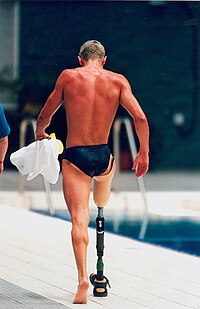
Photo from wikipedia
OBJECTIVE Proprioceptive information plays an important role for recognizing and coordinating our limb's static and dynamic states relative to our body or the environment. In this study, we determined how… Click to show full abstract
OBJECTIVE Proprioceptive information plays an important role for recognizing and coordinating our limb's static and dynamic states relative to our body or the environment. In this study, we determined how artificially evoked proprioceptive feedback affected the continuous control of a prosthetic finger. APPROACH We elicited proprioceptive information regarding the joint static position and dynamic movement of a prosthetic finger via a vibrotactor array placed around the subject's upper arm. Myoelectric signals of the finger flexor and extensor muscles were used to control the prosthesis, with or without the evoked proprioceptive feedback. Two control modes were evaluated: the myoelectric signal amplitudes were continuously mapped to either the position or the velocity of the prosthetic joint. MAIN RESULTS Our results showed that the evoked proprioceptive information improved the control accuracy of the joint angle, with comparable performance in the position- and velocity-control conditions. However, greater angle variability was prominent during position-control than velocity-control. Without the proprioceptive feedback, the position-control tended to show a smaller angle error than the velocity-control condition. SIGNIFICANCE Our findings suggest that closed-loop control of a prosthetic device can potentially be achieved using non-invasive evoked proprioceptive feedback delivered to intact participants. Moreover, the evoked sensory information was integrated during myoelectric control effectively for both control strategies. The outcomes can facilitate our understanding of the sensorimotor integration process during human-machine interactions, which can potentially promote fine control of prosthetic hands.
Journal Title: Journal of neural engineering
Year Published: 2021
Link to full text (if available)
Share on Social Media: Sign Up to like & get
recommendations!